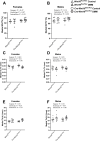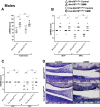Induced inactivation of Wnt16 in young adult mice has no impact on osteoarthritis development
- PMID: 36367882
- PMCID: PMC9651579
- DOI: 10.1371/journal.pone.0277495
Induced inactivation of Wnt16 in young adult mice has no impact on osteoarthritis development
Abstract
Osteoarthritis (OA) is a common disorder and a major cause of disability in the elderly population. WNT16 has been suggested to play important roles in joint formation, bone homeostasis and OA development, but the mechanism of action is not clear. Transgenic mice lacking Wnt16 expression (Wnt16-/-) have a more severe experimental OA than control mice. In addition, Wnt16-/- mice have a reduced cortical thickness and develop spontaneous fractures. Herein, we have used Cre-Wnt16flox/flox mice in which Wnt16 can be conditionally ablated at any age through tamoxifen-inducible Cre-mediated recombination. Wnt16 deletion was induced in 7-week-old mice to study if the Cre-Wnt16flox/flox mice have a more severe OA phenotype after destabilizing the medial meniscus (DMM surgery) than littermate controls with normal Wnt16 expression (Wnt16flox/flox). WNT16 deletion was confirmed in articular cartilage and cortical bone in Cre-Wnt16flox/flox mice, shown by immunohistochemistry and reduced cortical bone area compared to Wnt16flox/flox mice. After DMM surgery, there was no difference in OA severity in the articular cartilage in the knee joint between the Cre-Wnt16flox/flox and Wnt16flox/flox mice in neither female nor male mice. In addition, there was no difference in osteophyte size in the DMM-operated tibia between the genotypes. In conclusion, inactivation of Wnt16 in adult mice do not result in a more severe OA phenotype after DMM surgery. Thus, presence of WNT16 in adult mice does not have an impact on experimental OA development. Taken together, our results from Cre-Wnt16flox/flox mice and previous results from Wnt16-/- mice suggest that WNT16 is crucial during synovial joint establishment leading to limited joint degradation also later in life, after onset of OA. This may be important when developing new therapeutics for OA treatment.
Copyright: © 2022 Törnqvist et al. This is an open access article distributed under the terms of the Creative Commons Attribution License, which permits unrestricted use, distribution, and reproduction in any medium, provided the original author and source are credited.
Conflict of interest statement
The authors have declared that no competing interests exist.
Figures




Similar articles
-
Wnt16 Overexpression in Osteoblasts Increases the Subchondral Bone Mass but has no Impact on Osteoarthritis in Young Adult Female Mice.Calcif Tissue Int. 2020 Jul;107(1):31-40. doi: 10.1007/s00223-020-00682-7. Epub 2020 Mar 5. Calcif Tissue Int. 2020. PMID: 32140758 Free PMC article.
-
Inducible Wnt16 inactivation: WNT16 regulates cortical bone thickness in adult mice.J Endocrinol. 2018 May;237(2):113-122. doi: 10.1530/JOE-18-0020. Epub 2018 Mar 12. J Endocrinol. 2018. PMID: 29530924 Free PMC article.
-
Liver-derived IGF-I is not required for protection against osteoarthritis in male mice.Am J Physiol Endocrinol Metab. 2019 Dec 1;317(6):E1150-E1157. doi: 10.1152/ajpendo.00330.2019. Epub 2019 Oct 22. Am J Physiol Endocrinol Metab. 2019. PMID: 31638855
-
Wnt16 signaling in bone homeostasis and osteoarthristis.Front Endocrinol (Lausanne). 2022 Dec 22;13:1095711. doi: 10.3389/fendo.2022.1095711. eCollection 2022. Front Endocrinol (Lausanne). 2022. PMID: 36619549 Free PMC article. Review.
-
Osteoarthritis: toward a comprehensive understanding of pathological mechanism.Bone Res. 2017 Jan 17;5:16044. doi: 10.1038/boneres.2016.44. eCollection 2017. Bone Res. 2017. PMID: 28149655 Free PMC article. Review.
Cited by
-
WNT16 Regulation of the Articular Chondrocyte Phenotype in Mice.Life (Basel). 2023 Mar 25;13(4):878. doi: 10.3390/life13040878. Life (Basel). 2023. PMID: 37109407 Free PMC article.
-
WNT16 primer.Differentiation. 2025 Mar-Apr;142:100833. doi: 10.1016/j.diff.2024.100833. Epub 2024 Dec 20. Differentiation. 2025. PMID: 39730242 No abstract available.
References
-
- Nusse R, Clevers H. Wnt/beta-Catenin Signaling, Disease, and Emerging Therapeutic Modalities. Cell. 2017;169(6): 985–99. - PubMed
Publication types
MeSH terms
Substances
LinkOut - more resources
Full Text Sources
Medical
Molecular Biology Databases

